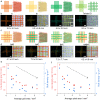Woven organic crystals
- PMID: 37990025
- PMCID: PMC10663483
- DOI: 10.1038/s41467-023-43084-7
Woven organic crystals
Abstract
Woven architectures are prepared by physical entanglement of fibrous components to expand one-dimensional material into two-dimensional sheets with enhanced strength and resilience to wear. Here, we capitalize on the elastic properties of long organic crystals with a high aspect ratio to prepare an array of centimeter-size woven network structures. While being robust to mechanical impact, the woven patches are also elastic due to effective stress dissipation by the elasticity of the individual warp and weft crystals. The thermal stability of component crystals translates into favorable thermoelastic properties of the porous woven structures, where the network remains elastic over a range of 300 K. By providing means for physical entanglement of organic crystals, the weaving circumvents the natural limitation of the small size of slender organic crystals that is determined by their natural growth, thereby expanding the prospects for applications of organic crystals from one-dimensional entities to expandable, two-dimensional robust structures.
© 2023. The Author(s).
Conflict of interest statement
The authors declare no competing interests.
Figures







References
-
- Adanur, S. Handbook of Weaving (Lancaster, PA, 2001).
-
- Becker, J. Pattern and Loom: A Practical Study of the Development of Weaving Techniques in China, Western Asia and Europe (NIAS Press, 2014).
-
- Ray, S. C. Fundamentals and Advances in Knitting Technology (CRC Press, 2012).
-
- Misnon MI, Islam MM, Epaarachchi JA, Lau K. Potentiality of utilising natural textile materials for engineering composites applications. Mater. Design. 2014;59:359–368. doi: 10.1016/j.matdes.2014.03.022. - DOI
-
- Turney, J. The Culture of Knitting (Berg, 2009).
Grants and funding
LinkOut - more resources
Full Text Sources
Medical

